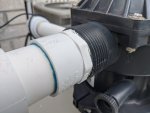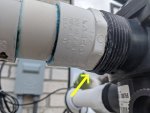First off, many thanks to everyone on this forum. I have learned so much and resolved so many issues with info from this site that I can't even count.
This year, our plumbing appears to have developed a couple of slow drips where there are PVC connections to the multiport valve atop our sand filter. The drip appears to be coming from the joint between the white PVC and the black multiport valve. I'm confused by how the PVC is attached, though, since the pool was installed by the previous homeowner I didn't see how this stuff went together. I see outer threads, but those clearly aren't being used for anything. Instead, it looks like the PVC is maybe stuck inside the multiport valve connection and sealed with some kind of cement? I've attached a couple of photos that hopefully show what I'm talking about. The pictured connection is the pump output going into the filter. It hasn't been altered or disturbed in the ~5 years I've owned the house/pool.
Assuming that's where the leak is coming from, how would I go about repairing this? Is this a "right" way to have connected this plumbing and, if not, is there a better way to repair it?
Thanks much for your insight!
-Bob
This year, our plumbing appears to have developed a couple of slow drips where there are PVC connections to the multiport valve atop our sand filter. The drip appears to be coming from the joint between the white PVC and the black multiport valve. I'm confused by how the PVC is attached, though, since the pool was installed by the previous homeowner I didn't see how this stuff went together. I see outer threads, but those clearly aren't being used for anything. Instead, it looks like the PVC is maybe stuck inside the multiport valve connection and sealed with some kind of cement? I've attached a couple of photos that hopefully show what I'm talking about. The pictured connection is the pump output going into the filter. It hasn't been altered or disturbed in the ~5 years I've owned the house/pool.
Assuming that's where the leak is coming from, how would I go about repairing this? Is this a "right" way to have connected this plumbing and, if not, is there a better way to repair it?
Thanks much for your insight!
-Bob




 It looks like the previous owners used a slip adapter of sorts and glued it into the MPV. That stinks. I suppose the only way you'll know if you can remove all of that is to try and turn those parts. Your success will depend on what glue they used. If it was something designed to be permanent like PVC glue .... uh oh. Twisting might break the MPV. You might have to try and use a blow dryer or heat gun (carefully) to try and weaken the grip of that glue. If you get lucky and they just used something semi-permanent like a silicone or something, it may not be that bad.
It looks like the previous owners used a slip adapter of sorts and glued it into the MPV. That stinks. I suppose the only way you'll know if you can remove all of that is to try and turn those parts. Your success will depend on what glue they used. If it was something designed to be permanent like PVC glue .... uh oh. Twisting might break the MPV. You might have to try and use a blow dryer or heat gun (carefully) to try and weaken the grip of that glue. If you get lucky and they just used something semi-permanent like a silicone or something, it may not be that bad. That would nice.
That would nice.